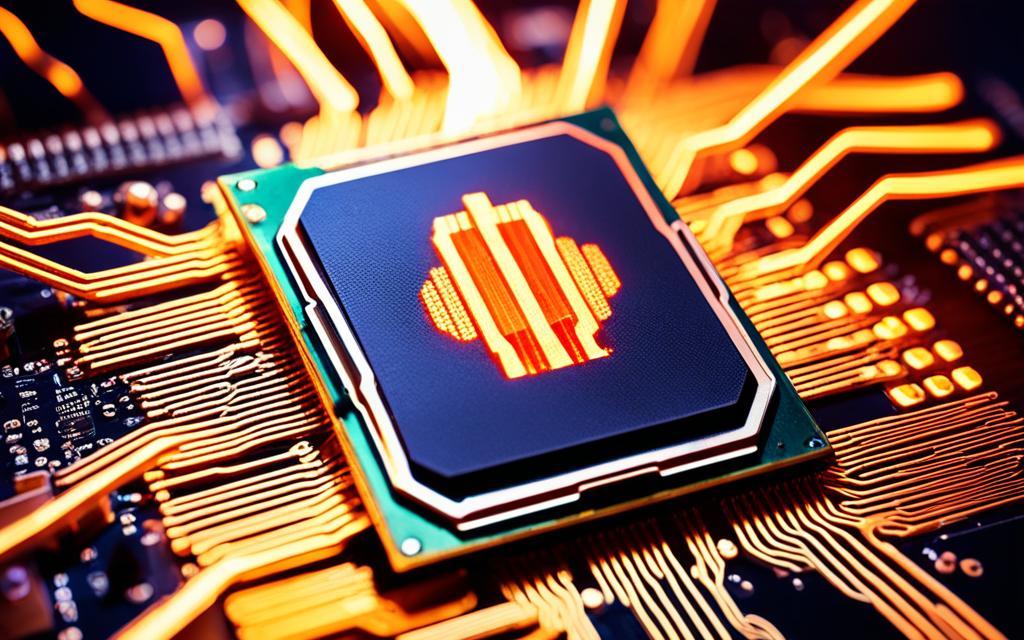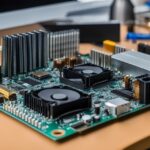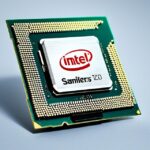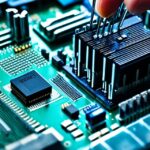Table of Contents
CPU overclocking is a hot topic as people look to boost their computer’s power for tough tasks. Some folks deliberately increase their CPU speeds beyond what’s recommended. But, there’s worry when CPUs speed up on their own, without any settings changed by the user. This can cause overclocking issues, like uneven performance and possible damage to the parts.
We’ll explore why CPUs might overclock themselves by mistake, what this means for your computer, and how to keep an eye on and control CPU speeds. Knowing why this happens is important to keep your computer working well and lasting long, especially now as CPUs are asked to do more during heavy workloads123.
Key Takeaways
- Overclocking raises CPU speeds, helping with heavy-duty tasks.
- Unchecked spontaneous overclocking might cause system issues.
- Tools to monitor CPU performance are key.
- Effective cooling keeps overclocked CPUs at safe temperatures.
- Special software aids overclocking for Intel and AMD CPUs.
- It’s important to know how overclocking affects your warranty.
Understanding CPU Overclocking
Understanding CPU overclocking starts with its basic ideas. The definition of overclocking is making a CPU run faster than the maker’s speed. This can make your computer faster for games and programs. But, going too fast might break the CPU or make it unstable.
What is Overclocking?
Overclocking lets you change settings like the clock multiplier and base frequency in the BIOS. This can make your CPU faster for gaming and tough programs4. Some products come with built-in settings to go fast but stay safe. Be careful though. Too much overclocking can overheat or harm your CPU4.
CPU Specifications and Limits
CPU specs tell you the fastest safe speed. You might see a 3.6GHz CPU go up to 4.7GHz, showing overclocking’s possible gains5. But, each CPU from Intel or AMD has a speed limit. Going over it might end badly46.
The Role of System BIOS
The system BIOS is key for overclocking. It’s where you adjust settings for your hardware. Users can turn on AI overclocking or change voltages for stable speeds. But, it’s important to watch your CPU’s heat and how well it performs when overclocking4. Staying in balance is key to avoid overheating6.
Why is my CPU overclocking itself?
Sometimes, your CPU may run faster than expected. This often happens due to special features in the BIOS settings. One main feature is the AI optimization, which boosts performance based on the computer’s power. However, this can make the CPU speed up too much, without you knowing. For example, a CPU set to run at 3.6GHz might end up at 4.7GHz because of these settings. This shows how AI overclocking can unintentionally cause problems with stability and keeping the computer cool5.
AI Optimisation Features in BIOS
Computer makers have created systems that let AI manage overclocking. This dynamic adjustment increases speed during intense workloads. But, it also raises power use. As the CPU gets hotter, the need for efficient cooling grows. This is vital for balancing fast performance against the risk of overheating. If overlooked, your computer’s health might be at risk2.
Power Management Settings
Alongside BIOS’s AI, the OS’s power settings also boost the CPU’s performance. When you use demanding programs, these adjustments help but also increase power management needs. A properly set up system can handle this, making complex tasks run smoothly. It’s crucial to keep an eye on your settings. This ensures your computer performs well without risking damage or instability from too much power7.
Potential Causes of Unintentional Overclocking
Understanding why unintentional overclocking happens can keep your computer running well. You might face this due to several things. These include BIOS settings that are too aggressive, or software clashing with your system. You may also find issues with hardware not working well together. Each needs looking into to fix the problem.
Default Settings and Misconfigurations
A lot of motherboards are set up to run fast from the start. This can make your computer unstable and seem like it’s overclocking by itself. BIOS settings that aren’t right, especially in new systems, can make the CPU run too hot. This makes it hard for the computer to work properly.
Faulty Software and Driver Issues
Driver problems often cause overclocking issues. When drivers are old or don’t fit well with your system, your CPU can act up. Making sure your drivers are up to date can prevent these problems. It helps your system run smoothly and stops it from getting too hot.
Hardware Limitations and Compatibility Issues
Getting hardware that works well together is key. If your power supply isn’t strong enough, it can’t keep everything running right. For instance, a weak power supply might not give the CPU enough power. This can make it overheat and perform poorly. Keeping an eye on temperatures and making sure your hardware matches up can stop these issues.
Potential Cause Description Default BIOS Settings Optimised defaults may push CPUs beyond safe performance levels, resulting in instability. BIOS Misconfigurations Incorrect settings during system setup can lead to unexpected clock speeds. Driver Conflicts Outdated drivers may cause erratic CPU behaviour, affecting stability. Hardware Compatibility Issues Inadequate power supplies can lead to performance dips and heating problems. How to Monitor and Control CPU Speeds
To get the best performance without overclocking, watching and managing CPU speeds is key. There are ways to check CPU usage and adjust it as needed. This makes sure your computer runs smoothly.
Using Monitoring Software
There’s monitoring software to help check your CPU’s speed. NZXT CAM and Intel® Extreme Tuning Utility (XTU) are two examples. They show you live CPU temps and speeds. You get graphs that display how well your CPU is working. This helps you decide how to manage CPU settings. With AI Assist in Intel XTU version 7.13.0.x, you get extra help to boost CPU efficiency8.
Adjusting Power Settings in Windows
Changing Windows power settings can improve how your CPU performs. Set the max processor state to control top CPU speeds. It helps keep CPU speed in check. Lowering these settings can make your computer more stable. It also solves overheating issues, giving you a better computing experience with Windows power settings.
Manual BIOS Adjustments
For those who know their way around a computer, changing BIOS settings manually adds more control. Turn off auto-overclocking and set your CPU speeds yourself. This keeps your CPU safe. These BIOS adjustments prevent overheating from overclocking. Adjusting your BIOS right can make CPU voltages stable and improve its performance. Speed calibration is helpful. It’s key to watch your temperatures closely after these changes to stop overheating9.
Method Benefits Considerations Monitoring Software Real-time tracking of speeds and temperatures Requires compatible hardware and software Windows Power Settings Control CPU performance levels May limit CPU capabilities Manual BIOS Adjustments Fine-tune CPU performance settings Risk of destabilising the system if misconfigured Conclusion
The world of CPU overclocking has changed a lot, making computers faster but also riskier. It’s key to know how settings like Intel Turbo Boost and AMD Precision Boost work. They might overclock your CPU by themselves if you’re not careful with your BIOS settings and how you manage power10. Even though overclocking is exciting, you must keep an eye on your computer’s stability. High temperatures and bad cooling can seriously harm your computer11.
To keep your CPU running well, you need to watch and adjust its speed regularly. This stops problems and keeps your computer working well for longer. You should also watch out for driver conflicts and malware, which might mess up an overclocked computer12. By using the right monitoring tools and following good advice, you can enjoy overclocking safely.
Choosing to overclock means you need to learn a lot about it. Be careful and ready to learn more. For more information, you can look into safe overclocking methods and tricks. This will help you make smart choices in the changing world of technology for managing CPU speeds.
FAQ
What is CPU overclocking?
CPU overclocking means pushing a processor’s clock speed past what the maker set to up performance. This boosts processing but risks instability and damage.
How can I tell if my CPU is overclocking itself?
If your CPU speeds are higher than its spec sheet, it might be self-overclocking. Use monitoring software to check CPU speeds in real-time.
What features in BIOS could cause spontaneous CPU overclocking?
BIOS’s AI Optimisation can tweak settings based on heat and power, sometimes raising CPU speeds too high without meaning to.
How do power management settings affect CPU performance?
Operating system power settings can change CPU speeds for tough tasks. This could cause accidental overclocking if not watched.
What are the common causes of unintentional overclocking?
Unplanned overclocking often comes from BIOS’s default high-performance settings, system build errors, driver clashes, and hardware that messes with expected performance.
What tools can I use to monitor my CPU speed?
Tools like NZXT CAM and HWMonitor let you see CPU speeds and temperatures live. They help you keep performance great without overclocking.
How can I adjust windows power settings for CPU management?
In Windows power settings, you can limit the CPU’s performance to prevent it from going over its speed limit during hard work.
What manual adjustments can I make in BIOS to prevent overclocking?
You can turn off auto-overclocking, set speeds to suggested levels, and ensure all settings match the manufacturer’s to keep the system stable.
Source Links
- https://www.digitaltrends.com/computing/should-you-overclock-your-pcs-processor/ – What is Overclocking and Should You Overclock Your CPU? | Digital Trends
- https://www.intel.com/content/www/us/en/gaming/resources/5-reasons-to-overclock-your-next-pc.html – 5 Reasons to Overclock Your Next PC – Intel
- https://www.makeuseof.com/best-cpu-overclocking-software/ – The 6 Best Overclocking Software to Boost PC Performance
- https://www.techylop.com/why-is-my-cpu-overclocking-itself/ – Why Is My CPU Overclocking Itself – Need To Know In 2024!
- https://www.overclock.net/threads/my-cpu-is-overclocking-itself.1727676/ – My CPU is overclocking itself
- https://ms.codes/blogs/computer-hardware/why-is-my-cpu-overclocking-itself – Why Is My CPU Overclocking Itself
- https://www.avast.com/c-how-to-overclock-cpu – How to Safely Overclock Your CPU for PCs & Laptops
- https://www.intel.com/content/www/us/en/gaming/resources/how-to-overclock.html – How to Overclock Your Unlocked Intel® Core™ Processor
- https://www.overclock.net/threads/is-my-cpu-overclocking-itself-what-the.1174440/ – Is my CPU overclocking itself? What the..
- https://softwareg.com.au/blogs/computer-hardware/why-is-my-cpu-overclocking-itself – Why Is My CPU Overclocking Itself
- https://en.wikipedia.org/wiki/Overclocking – Overclocking
- https://erickimphotography.com/blog/2018/09/21/overclock-yourself/ – OVERCLOCK YOURSELF. – ERIC KIM








